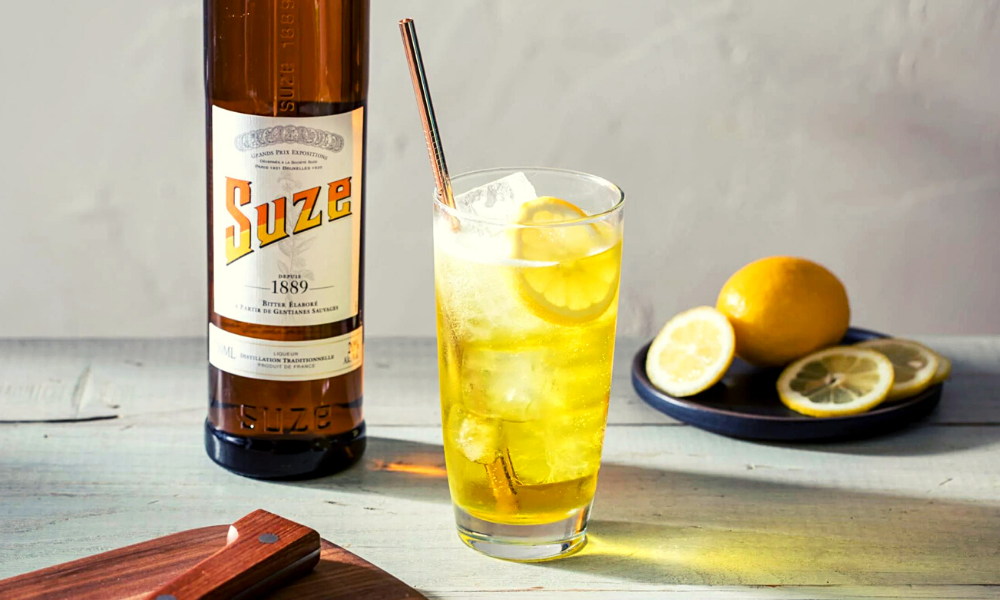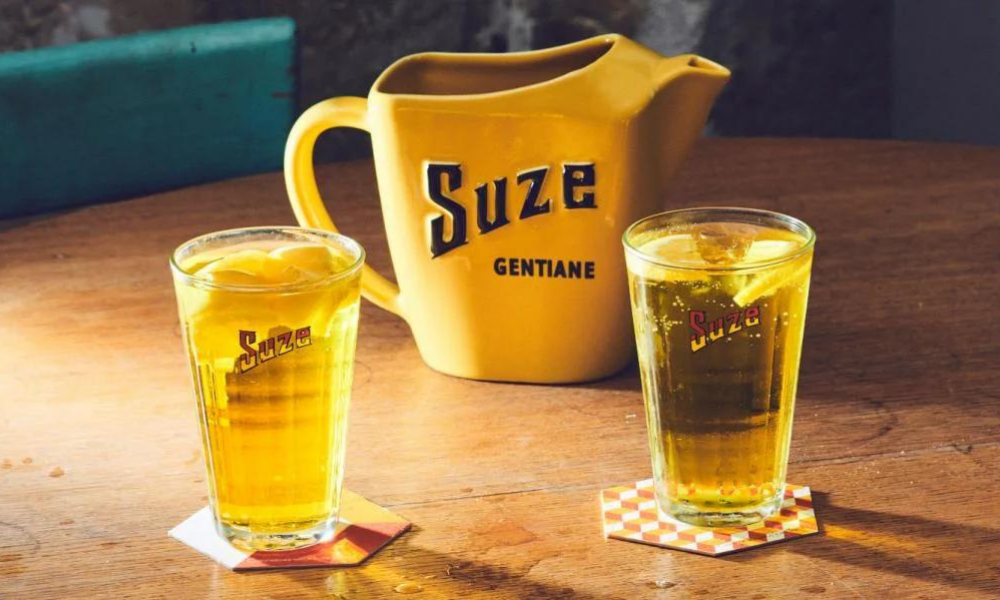Ferdinand Moureaux, who had acquired his family’s distillery in Maisons-Alfort, first put Suze on the market under the name Picotin in 1889 during the Paris World Fair. In 1898, the name was changed to Suze, which could be tied to Moureaux’s sister-in-law Susanne Jaspert or the river Suze in Switzerland, where Moureaux is reported to have purchased the recipe in 1885 or 1914.
In his collage Verre et bouteille de Suze from 1912, Pablo Picasso depicts a bottle of Suze. Suze became one of France’s most popular alcoholic drinks between the two World Wars thanks to aggressive marketing (including sponsorship of the Tour de France in 1933).
What is Suze?
Suze is a French liqueur created from a blend of farmed and wild gentian macerated in alcohol for a year before distillation and combining, according to a recipe dating back to the late 1800s. The yellow gentian (Gentiana Lutea), prized for its bitterness and color, grows in the Jura, Vosges, Pyrénées, Alps, and Auvergne mountains above 800-900 meters and takes 20-30 years to completely mature.
Suze employed a 50:50 blend of wild gentian root gathered by hand and cultivated gentian root that can be grown more swiftly in 9-13 years and can use more mechanical harvesting utilizing machinery created expressly for the procedure to maintain the gentian sustainability. The Suze Bouquet, an angelica root distillate with a secret mix of herbs and fruit extracts, completes the drink’s unique flavor profile and the predominant gentian root flavor.
Suze is unmistakably a bitter aperitif (we are no strangers to here). The primary ingredient is gentian root, notably Gentiana lutea (Great Yellow Gentian), responsible for the drink’s bitter, vegetal qualities. Gentian is also found in various non-alcoholic and alcoholic beverages, including Gentian (obviously) and Moxie, a soft drink.
The plant may be found in Switzerland and France, an excellent place to start. Suze works well in cocktails and straight up as a pre-or post-dinner drink. Baird compares it to adding soy or umami to a meal to give it that extra bite.
Where is Suze from, and when was it Created?
Fernand Moreaux in the Swiss hamlet of Sonvilier produced Suze in the 1880s (it was made in 1885, but it wasn’t put on the market until 1889). There are two origin legends for the name, both recognized, but none of which can be verified. According to the first, Suze references Moreaux’s sister, Suzanne. According to the second, the name Suze comes from the Suze River, which runs near where Moreaux is claimed to have gathered the components for the spirit. When Moreaux took Suze to the Exposition Universelle (“World’s Fair”) in Paris in 1889, it got its big break.
Suze’s popularity expanded after it arrived in France, to the point where it was the subject of Pablo Picasso’s 1912 painting La Bouteille de Suze (Bottle of Suze). Suze is produced in Thuir, France, close to the Spanish border. Suze is created over a little more than a year. First, the prepared gentian is macerated for at least a year in alcohol. The liquid obtained from pressing the gentian roots is then used in distillation. Other aromatic components are then added to complete the finished product.
How do you Use Suze?
Suze is great on ice, in my opinion, while some people may find this technique to be overly bitter. Suze is also deliciously served simply with a lemon twist, thanks to its citrus tones. Suze loves carbonation, so try it with soda water, tonic water, or sparkling wine. It goes well with pét-nat wine, similar vegetal and spicy flavor. Suze also works well with eau de vie, Cognac, and gin in a supporting role.
I propose adding a teaspoon to a martini for home bartenders. Suze can also be used as a cocktail rinse or atomize, an excellent way for home bartenders to experiment. To atomize Suze at home, purchase a tiny spray bottle, fill it with Suze, and spritz. Suze’s distinctive color, practically fluorescent yellow, is also worth mentioning. This is an excellent way for a home bartender to add color to a gathering.
Suze is a renaissance spirit with a low alcohol content (just 20% ABV) and the ability to work effectively in various contexts and drinks. There’s a chance you’ll be able to employ Suze, depending on what you’re attempting to accomplish and your palette. Straight or on the rocks would be my first choice. Suze and soda, Suze and tonic, or as an ingredient to traditional beverages like martinis are all simple possibilities. This lets you see the flavor profile in action before incorporating it into cocktails.
- Flavor Notes: vegetal, quenching, floral, delicate, bracing
- Perfect Pairings: tonic, soda water
- Liquors that Jive: Armagnac, gin, framboise eau de vie
- Stay Away From flavored vodka, amaro, American whiskey, molasses-driven rum, Branca Menta
What does Suze Taste Like?
Suze is a gentian-based aperitif, and gentian is an aromatic plant used as a bittering component in various French digestifs. It has a vegetal flavor, similar to eating dandelion leaves, but it also has citric tones, like pomelo and perfume-y citrus—not lemon or lime.
Suze liqueur has a gentian flavor, which is a bitters ingredient. It has a harsh and vegetal flavor. It tastes as it smells after spending a couple of hours cutting your yard’s plants and weeds. The flavor is harsh, spicy, earthy, and sweet at the same time. I treat it as bitter about gaining a sense of its core flavor. I dilute it with ice and ice soda water to observe how much of the herbaceous woodiness is tamed by dilution and lower temperatures.
How to Make a Suze Whiskey Sour (or Suze Gin Sour)?
Balance and proportions are crucial in any sour. To keep the flavor balanced, I used only 12 ounces of Suze. I added one egg white (or aquafaba) to the drink to soften and combine the flavors.
But let’s get back to the cocktail. Combine the lemon juice, pineapple syrup, Suze, and bourbon or rye whiskey in a shaker. If desired, add your foaming agent (egg white or aquafaba). Shake for 10-12 minutes with ice. If using an egg white or aquafaba, strain into a cocktail mixing glass and whisk for 20-30 seconds with a hand-held electronic latte whisk to create a nice foam head.
Pour into a coupe glass and enjoy. I used a cocktail cherry as a garnish, but a healthy topper will do the trick if you have fresh pineapple on hand.
How to Use Suze in Cocktails?
Suze’s bitterness tames overly sweet or sour drinks in a way that’s interesting on the tongue when used in conjunction with other flavors in the drink. Suze can be used in cocktails in the following ways:
- Start with less Suze and add to your taste preference
- Make sure you smell the flavor elements you’re combining. 80% of flavor comes from the aroma – so if it smells good together, it usually tastes great together.
- Use base spirits with complementary flavors – floral, citrusy, or slightly earthy and bitter.
- If your cocktail comes out too bitter, both sour and sweet elements can be used to tame an overly bitter drink. Think about serving over ice too. Chilling mutes aggressive flavors, and as a bitter drink dilutes over ice, it is often sweeter.
Conclusion
Suze is ideal for the back bar today, with its bitter flavor profile as tastes evolve and bartenders experiment with more complex flavors and beverages. Suze mixes a delicious White Negroni by combining equal parts Burleigh’s Export and Lillet Blanc, stirring with ice and garnishing with a twist of grapefruit peel.
Suze is commonly served in France with a single ice cube and a splash of water to cut the sweetness (even though the French product is less sweet, to begin with), or you could try my Romarin Fizz, which I created for the Suze & Byrrh mixology competition in London, which I discussed on the BartenderHQ Podcast.


